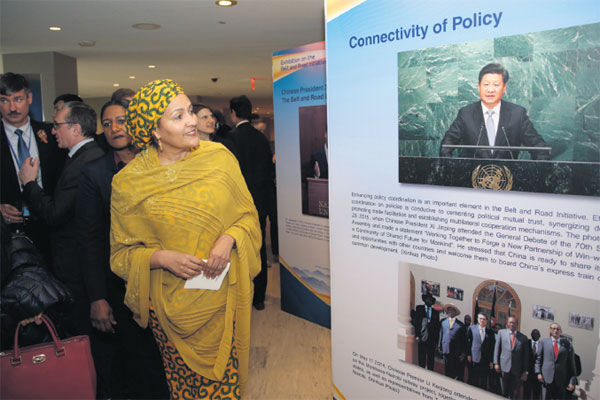Exhibition's spotlight on story of Belt and Road
What started as President Xi Jinping's proposal to draw together Asia, Europe and other areas through reviving the land and sea routes of the historic Silk Road has become a growing international movement embraced by many countries.
This is demonstrated in graphic form in a photo exhibition on the initiative, Strengthening International Cooperation for Win-Win Development, which opened at United Nations Headquarters in New York on May 8.
"The Belt and Road Initiative is not a solo by China, but a symphony performed by all the relevant parties," says Liu Jieyi, China's ambassador to the UN, in describing its core value.
|
Amina J. Mohammed, deputy secretary-general of the United Nations, examines a piece featuring President Xi Jinping in the photo exhibition Strengthening International Cooperation for Win-Win Development, which opened on May 8 in the New York headquarters of the UN. The exhibition opened just days before the start of the Belt and Road Forum for International Cooperation. Liao Pan / China News Service |
The exhibit, with about 40 photographs along the first floor's south wall, showcases the thinking behind the initiative, its achievements and its prospects and promises.
Photos are divided into five sections: Policy Coordination, Facilities Connectivity, Unimpeded Trade, Financial Integration and People-to-People Bond - in line with the initiative's five focuses.
The initiative, which comprises the Silk Road Economic Belt and the 21st Century Maritime Silk Road, was proposed by Xi in 2013 to enhance complementarity and promote common progress through closer international cooperation. Infrastructure investments and improved trade are major components.
It is rooted in the Silk Road spirit of "peace and cooperation, openness and inclusiveness, mutual learning and mutual benefit", and follows the principle of "extensive consultation, joint contribution and shared benefits", Liu says.
The initiative does not aim to replace any existing regional platform or initiative, but to seek synergy and achieve common development through closer international cooperation, he says.
Countries involved in the initiative have their own resource advantages, and their economies are mutually complementary. This provides great potential for cooperation, he adds.
Liu says that three years after its launch, the initiative has received widespread recognition across the world and reaped important early harvests: More than 130 countries and international organizations have expressed their support, and more than 40 of them have concluded cooperation agreements with China.
"This concerted effort has registered steady progress; the economic corridor development is making headway; trade and investment are growing substantially; key joint projects are well underway," Liu says.
It also strongly reinforces the mission of the United Nations.
"Everybody is extremely excited because it is a demonstration of the global partnership that really fits the ambition of the 2030 Agenda (for Sustainable Development)," says Amina J. Mohammed, deputy secretary-general of the UN.
xiaohong@chinadailyusa.com



















